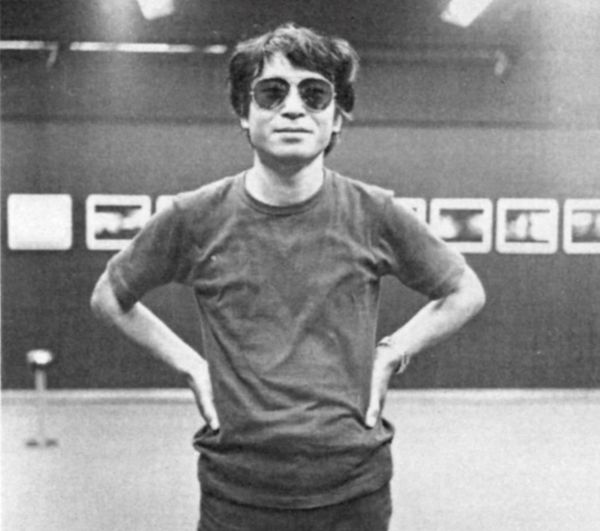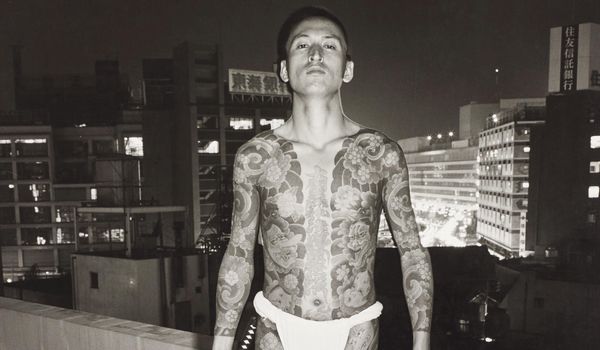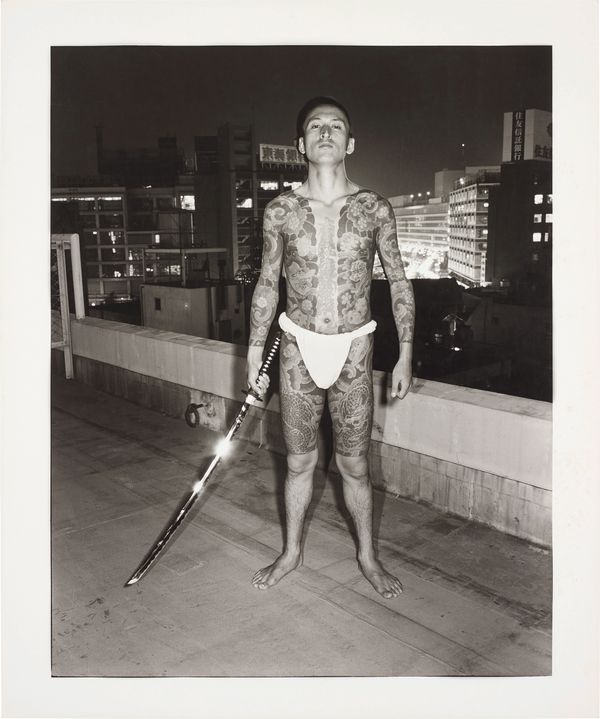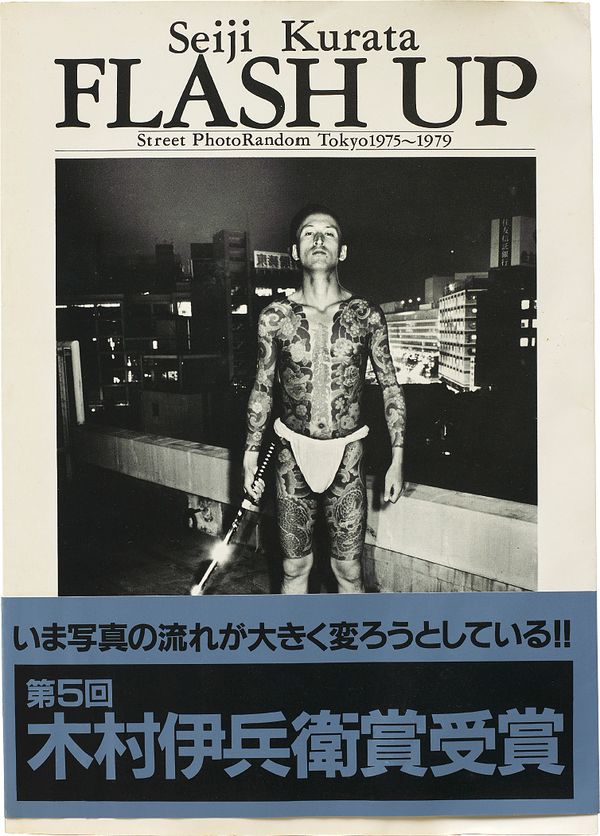Seiji Kurata 入墨の男 [Irezumi no otoko] Tattooed Man from Flash Up, 1975 (detail). Gelatin silver print, printed 1978.
For this season's ULTIMATE, we have curated a multifaceted selection of photographs ranging from rare masterpieces to unique works and sold-out editions. Seiji Kurata joins an elite group of artists whose works are presented exclusively at Phillips Berkeley Square.
Beginnings
When Seiji Kurata was 30 years old, he took a life changing gamble. Drawn to photography, he quit his job at a small thermostat factory and gave himself one year to pursue his new-found passion. Initially interested in 8mm films, which he kept as a hobby while working at the factory, Kurata was introduced by a friend to 35mm film, the darkroom process as well as a future source of inspiration, Daidō Moriyama. Wanting to see Moriyama's work, Kurata would visit his local second-hand bookshop for back issues of popular photography magazines like Asahi Camera and Camera Mainichi.

Seiji Kurata © Seiji Kurata
It was during this one-year hiatus that Kurata joined the independent photography school WORKSHOP, featuring faculty photographers Shōmei Tōmatsu, Eikoh Hosoe, Masahisa Fukase, Daidō Moriyama, Nobuyoshi Araki and Noriaki Yokosuka. Spearheaded by the leading photographers of the time, both the school (1974-76) and its eponymous quarterly periodical (1974-76, 8 volumes), were highly influential. A student could choose which photographer's seminar to take, and for him, the choice to study under Moriyama was clear. According to Kurata, what he took away from this experience was the greatness of the Japanese proverb「芸は身を助く」 [Gei wa mi wo tasuku], which translates to "Art brings bread," meaning "Learn a trade, for the time will come when you shall need it."
I smell blood in Kurata's photographs.
— Shōmei Tōmatsu
Tattooed Man
In summer 1975, while taking Moriyama's one-year seminar at WORKSHOP, Kurata began photographing the seedy streets of Ikebukuro in north-western Tokyo at night, using a medium-format camera (Asahi Pentax 6 x 7 cm) and a strong 15 x 20 cm strobe. Focusing on the underbelly of Japanese society, his subjects included yakuza, strippers, transvestites, prostitutes and their clients.
Seiji Kurata 入墨の男 [Irezumi no otoko] Tattooed Man from Flash Up, 1975
Tattooed Man — the powerful and provocative photograph presented in our London Photographs sale on 18 May — shows a heavily tattooed yakuza in his loincloth, with neck extended and samurai sword in hand, standing on a building rooftop. This captivating photograph was taken in October 1975 during Kurata's first year of nightly adventures in the entertainment district of Ikebukuro where he encountered scenes he described as 'whirlpools of excitement.' Writing in 2013, Kurata recalled his indelible encounter with the yakuza that resulted in this iconic photograph:
The town is bright with streetlights, pubs, game centres, cafes, restaurants, arrays of neon and spotlights. Two tall men call out to me. They look and act like playboys.
– Hey you, that's a big camera, huh? I bet it takes good photos. Take one of us!
– Huh, black and white? Are you broke?
– What, don't you even have colour?
– Not even a studio?
– Money! Sure, we'll pay you.
As if following a script, they keep up their big talk. I try hard to break in, saying I can't do it in the middle of a crowd of people, or that I might be caught by the police, but in the end I promise to photograph them three days later. There are no nice landscapes, no skylines or good scenery, and we decide to make the top of a building our studio. On the emergency staircase the two play for ages with their swords like actors in a samurai film and tell me to make them look like [the actor] Ken Takakura. They also tell me to show them all the photos taken, and to make big prints of any that are good.
During the three-hour rooftop shoot that began at midnight, Kurata photographed mostly in colour at the request of the yakuza who wanted to capture the rich colours of his extraordinary tattoos. (Kurata preferred to shoot in black and white as colour film was more expensive in those days.) When he did switch to black-and-white film, the battery of the strobe was running low. In this one photograph — referred by Kurata as 'a miracle shot' — taken as the final frame of his film, only a moment before the strobe battery died, Kurata cut through the darkness with his bright flash to reveal the pride, courage and determination of this yakuza.
When he first saw this photograph in the darkroom, it took him by surprise and he realised then that he had 'the shot.'
Publications, Exhibitions & Collections
After a year of documenting urban marginality, a selection of the resulting photographs were published for the first time in 1976 in the eighth and final issue of WORKSHOP under the title '謹写∙池袋の夜' [Kinsha ∙ Ikebukuro nights]. Kinsha loosely means "to photograph with respect," and Kurata's choice of this word speaks volumes about his outlook on the act of photographing and the subjects he encountered.
The present photograph Tattooed Man was first published in 1977 for the January issue of Camera Mainichi, the monthly photography magazine. Famed editor and curator Shōji Yamagishi had selected this work along with other Ikebukuro images by Kurata for a three-part feature titled Snap, published in the December 1977, January 1977 and February 1978 issues of the magazine. Soon after this publication, Kurata turned his camera and strobe on the darker side of Shinjuku — on the invitation of a nightclub owner in Ikebukuro who also had a club there — and expanded his subjects to include right-wing politicians, bōsōzoku [motorcycle gangs] and delinquents.
Four years into his series in 1978, Kurata held his maiden solo exhibition Tokyo: Night Dwellers, which took place in Europe at Canon Photo Gallery Amsterdam. Tattooed Man was chosen as the cover image for the accompanying publication in which Kurata wrote, "What I want to do is, to observe them. I want to see as many persons as possible as precisely as possible…It is a must to keep tight the surface tension of the world." The lot offered in this sale is the actual print that was exhibited in the show.
Kurata is for sure Weegee and Arbus' illegitimate child.
— Nobuyoshi Araki
S. Kurata, Flash Up: Street PhotoRandom, Tokyo 1975-1979, Tokyo, Byakuya Shobō, 1980
Kurata's first exhibition in Japan Street PhotoRandom Tokyo 1975-1979 was held the following year in 1979 at Nikon Salon Ginza in Tokyo. As the exhibition title suggests, Kurata's relationship with his rapidly changing city rested on chance and random encounters: "My Camera’s range randomly expands. Now, I follow instinct. Take whatever comes. I yield. Yes. At random, an exotic sequence. Yes. And yes again" (2013). The print of Tattooed Man that was included in the Nikon Salon Ginza show is held privately.
This exhibition title soon became the subtitle of his seminal photobook Flash Up: Street PhotoRandom Tokyo 1975-1979, which was released in 1980 to high acclaim. Including 190 black-and-white images, Flash Up was the culmination of five years of recording the urban underbelly. The title refers to Kurata’s method of using his strobe to bring to the surface things that occurred in the shadows — his "flashing up" of man's hidden desire, appetite and lust. On the back of the book's obi, endorsements were written by Shōmei Tōmatsu, Daidō Moriyama and Nobuyoshi Araki. In the same year, Kurata became the recipient of the 5th Kimura Ihei Award, one of the most coveted photography awards in Japan.
In The Photobook: A History Volume I, Martin Parr and Gerry Badger commented that "Seiji Kurata, a student of Daido Moriyama, has a unique photographic voice. Flash Up, his first photobook, is…one of the best debut publications since Nobuyoshi Araki's in the 1970s." As the cover image of Flash Up, Tattooed Man epitomised the raw and gritty underworld of 1970s Tokyo. In referring to his photographs taken in 1975-79, Kurata recently remarked, "If you asked me to take these pictures today, I couldn't. Those things that were previously hidden were all brought to the surface."
Kurata continued to publish notable photobooks, including Japan (1998), an anthology of his photographs taken in Japan that won the Kodansha Publishing Culture Award in 1999; and most recently in 2015, he launched Toshi no Zokei, a collection of Tokyo cityscapes published by Super Labo. Kurata's work is held in such prominent institutions as the International Center of Photography, the Brooklyn Museum and the Tokyo Photographic Art Museum. Both the Brooklyn Museum and the Tokyo Photographic Art Museum hold modern prints of Tattooed Man, 1975, in their respective collections.
Phillips extends our sincere thanks to Seiji Kurata for sharing his candid and insightful recollections.


